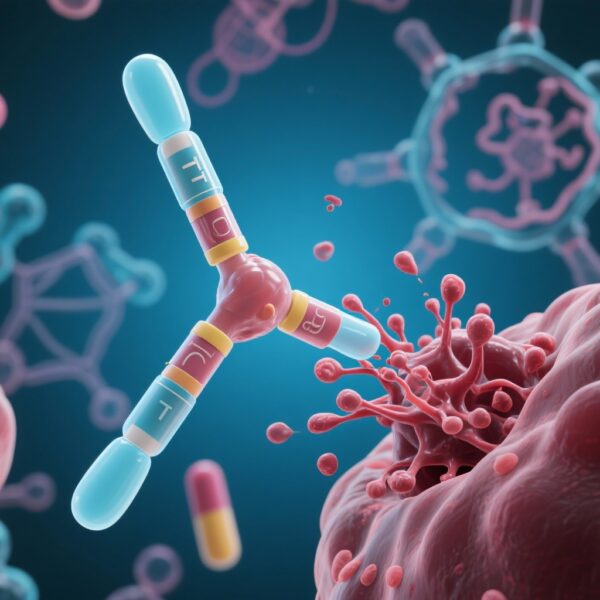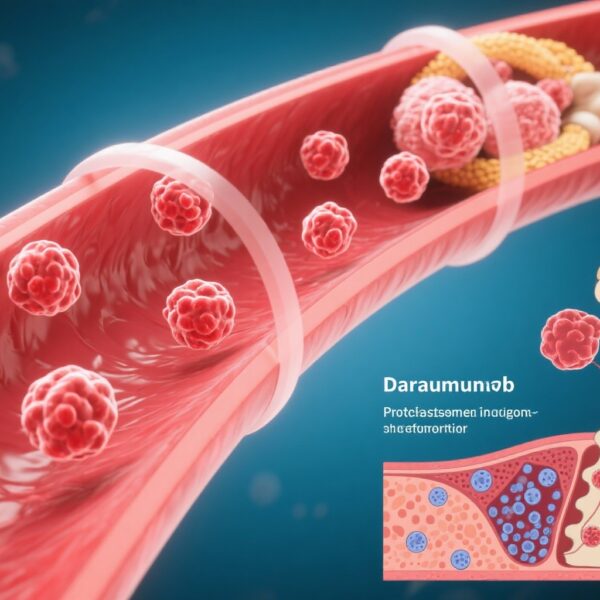Highlight
- The GEM12 phase 3 trial assessed high-dose busulfan-melphalan (BUMEL) versus melphalan (MEL200) conditioning following intensive VRD induction and consolidation in newly diagnosed multiple myeloma (NDMM) eligible for autologous stem cell transplantation (ASCT).
- BUMEL conditioning achieved a significantly higher 10⁻⁶ minimal residual disease (MRD)-negative rate (68% vs 58%) and demonstrated longer median progression-free survival (PFS) of 89 months versus 73.1 months with MEL200, though not reaching statistical significance overall.
- Subgroup analyses revealed pronounced PFS benefit with BUMEL in patients with advanced International Staging System (ISS) stages II or III and those harboring high-risk genetic abnormalities such as t(14;16) and del(1p).
- No new safety concerns were identified, supporting BUMEL as a potent conditioning regimen within an intensified VRD therapeutic framework.
Study Background
Multiple myeloma (MM) is a hematologic malignancy characterized by clonal proliferation of plasma cells in the bone marrow. Despite advances in therapy, including proteasome inhibitors and immunomodulatory drugs, high-dose chemotherapy followed by ASCT remains a standard of care for eligible patients to achieve long-lasting remission. Melphalan 200 mg/m2 (MEL200) remains the most widely used conditioning regimen pre-ASCT. However, retrospective data have suggested that the combination of busulfan plus melphalan (BUMEL) may result in deeper responses and longer progression-free survival (PFS).
With evolving induction therapies employing bortezomib, lenalidomide, and dexamethasone (VRD), it is critical to understand the optimal conditioning approach in the current therapeutic landscape. This study addresses the unmet need to optimize conditioning regimens to enhance the depth and durability of response post-ASCT in NDMM patients treated with intensified VRD regimens.
Study Design
The GEM12 trial was a prospective, open-label, phase 3 randomized study conducted between 2013 and 2015. It enrolled 458 patients with newly diagnosed multiple myeloma eligible for transplantation.
Patients received six cycles of reinforced VRD induction followed by ASCT conditioned with either BUMEL or MEL200, and two VRD consolidation cycles post-transplant. Randomization was executed using a 2 × 2 factorial design with a 1:1:1:1 allocation aiming to maintain balance with the subsequent GEM14 trial.
The primary endpoint was progression-free survival (PFS). Secondary endpoints included the minimal residual disease (MRD) negativity rate at a sensitivity threshold of 10⁻⁶, overall survival, and safety profiles. Subgroup analyses were predefined based on the International Staging System (ISS) stages I-III and high-risk cytogenetic abnormalities, including t(14;16) and deletion 1p.
Key Findings
After a median follow-up of 8.4 years, the trial reported one of the longest PFS durations documented in NDMM patients treated with modern induction, consolidation, and ASCT strategies.
- MRD-negative rates: The BUMEL group achieved a 68% 10⁻⁶ MRD-negative rate compared with 58% in the MEL200 group, with an odds ratio favoring BUMEL (1.51; P = .035), indicating a significantly deeper remission.
- Progression-Free Survival: Median PFS was 89.0 months for BUMEL versus 73.1 months for MEL200 (hazard ratio [HR], 0.89; 95% CI, 0.70–1.14; P = .3). Although this did not reach statistical significance for the overall population, notable benefits were observed in specific subgroups.
- Subgroup Benefits: Patients with higher ISS stages (II or III) demonstrated a PFS advantage with BUMEL conditioning. Similarly, those with high-risk cytogenetics including t(14;16) and del(1p) had improved outcomes with BUMEL. The median PFS combining ISS II/III patients treated with BUMEL and ISS I patients treated with MEL200 was 96.5 months (95% CI, 76 to not estimable), suggesting tailored conditioning strategies might optimize outcomes.
- Safety Profile: No new safety signals or increased toxicity were observed with BUMEL compared to MEL200 in this trial context, indicating that intensification with busulfan is well tolerated.
Expert Commentary
The GEM12 trial provides robust prospective evidence supporting the incorporation of busulfan into melphalan conditioning in the era of intensified VRD therapy, particularly for patients with advanced disease stage or adverse cytogenetics. The achievement of high MRD-negativity rates aligns with deep and durable remissions that are clinically meaningful for long-term disease control.
While the overall median PFS comparison was not statistically significant, the strong trend and subgroup analyses underscore the potential for risk-adapted transplantation conditioning strategies. These findings may influence forthcoming treatment guidelines and enable personalization of conditioning regimens based on disease risk.
Limitations include the open-label design and lack of overall survival difference at the current follow-up, highlighting the importance of extended monitoring for survival endpoints. Additionally, the factorial design allows for integration with other investigational therapies, a strength in harmonizing multi-phase development but complicating isolated regimen effect parsing.
Biologically, busulfan’s mechanism as an alkylating agent with a distinct DNA cross-linking profile may augment melphalan’s cytotoxicity, translating into enhanced myeloma cell eradication during conditioning.
Conclusion
The GEM12 phase 3 trial demonstrates that high-dose busulfan-melphalan as conditioning before ASCT following reinforced VRD induction and consolidation yields deeper MRD negativity and prolonged PFS in NDMM, especially among patients with advanced ISS and high-risk cytogenetics. Its tolerable safety profile supports its viability as a conditioning option.
These results advocate for risk-adapted ASCT conditioning strategies leveraging busulfan, potentially extending long-term disease control in multiple myeloma. Future research should further delineate survival benefits and integrate this approach within emerging therapeutic landscapes including monoclonal antibodies and cellular therapies.
Funding and ClinicalTrials.gov
The GEM12 trial was registered at ClinicalTrials.gov (NCT01916252) and the European Union Drug Regulating Authorities Clinical Trials Database (EudraCT 2012-005683-10).
References
Lahuerta JJ, San-Miguel J, Jiménez-Ubieto A, et al. High-dose busulfan-melphalan vs melphalan and reinforced VRD for newly diagnosed multiple myeloma: a phase 3 GEM trial. Blood. 2025 Oct 9;146(15):1747-1758. doi: 10.1182/blood.2025028313. PMID: 40499010.



